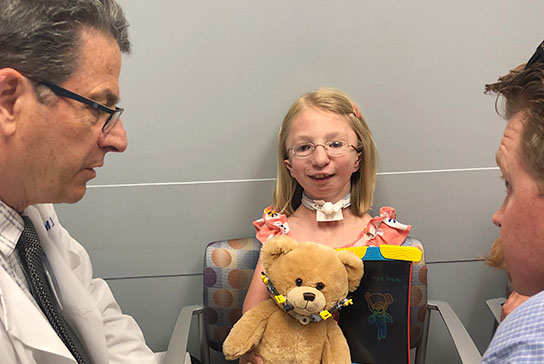Cranofacial anomalies – Cornelia de Lange Syndrome
Cornelia de Lange Syndrome is also sometimes referred to as CdLS for short or Brachman de Lange Syndrome.
What does Cornelia de Lange Syndrome mean for a child?
Cornelia de Lange Syndrome is diagnosed by clinical features. Children with this Syndrome often have long eyelashes, bushy eyebrows and synophrys (joined eyebrows). Their hairline may be lower than other family members, and they may have more body hair. These features are often less obvious in males after puberty. Children are often shorter than others in the family. None of these features may cause a problem for the person concerned; they are just clues for a diagnosis.
Cornelia de Lange Syndrome, however, is associated with other features that can cause problems. Children with Cornelia de Lange Syndrome do not necessarily have all of these problems and the severity of the problems does vary. Children with CdLS may have gastrointestinal tract difficulties. These can include vomiting, intermittent poor appetite, constipation, diarrhea or gaseous distention. The gastrointestinal symptoms range from mild to severe.
Most children with this Syndrome will have learning problems, although there have been children with CdLS reported with normal or only slightly below normal intelligence.
Language delay is a frequent finding. Speech can be very minimal, or even absent. There are a few children with fairly good language skills. Speech therapy can help in some children with CdLS. Improvement depends on many factors, including hearing, and the ability of the child to understand what the therapist is asking him/her to do.
Hearing loss is also associated with Cornelia de Lange Syndrome, varying from mild to severe. If hearing loss is conductive (sound is not conducted from the external ear to the inner ear) it is often possible to improve it by surgery. However, surgery is frequently unable to improve hearing if the hearing loss is sensorineural (in the inner ear, auditory nerve or auditory nerve centers of the brain). Hearing aids can help hearing in both types of hearing loss but if the loss is in the profound range, then hearing aids may only be able to help one hear general noise, and not individual words.
Eye problems may also be present. The types of eye problems associated with Cornelia de Lange Syndrome are strabismus (this is commonly called cross-eyed), nystagmus (a tremor in the eye), and myopia (near-sighted). Strabismus occurs as a result of the muscles of the eyes not being lined up correctly. Patching the eye can sometimes correct this problem without the need for surgery.
The jaw may be small and cleft palate is common. The cleft palate is usually repaired at around 12-18 months of age. Surgery may be needed if the jaw is so small that it makes it hard for the child to breathe. If and when surgery will be done depends on how small the lower jaw is and the health of the child.
There can be problems with the upper limbs. These range from webbed fingers (extra skin between the fingers), small hands to missing parts of digits whole digits or sometimes part of the arm.
Can Cornelia de Lange Syndrome occur more than once in a family?
A person with Cornelia de Lange is usually the only person in the family with this Syndrome. This means that the chance of recurrence is low, probably around 2-5%, or a 95-98% chance that it will not happen again. Cornelia de Lange Syndrome is thought to be an autosomal dominant syndrome, so if a person with CdLS has a child, the chance of that child having CdLS will be 50%. A few rare families have more than one person affected.
What causes Cornelia de Lange Syndrome?
The cause of Cornelia de Lange Syndrome is unknown, and as a result, there is no test for Cornelia de Lange. The diagnosis is made on the basis of clinical features.
Support group
Cornelia de Lange Syndrome Foundation, Inc.
Additional resources
- http://www.ncbi.nlm.nih.gov/omim
- Cornelia de Lange Syndrome Foundation, Inc.
- www.geneticalliance.org
References
- Jones K.L., Smith’s Recognizable Patterns of Human Malformation. 5th Edition. W.B. Soliders Company A Division of Harcourt Brace and Company, 1997.
- Online Mendelian Inheritance in Man, OMIM (TM). Johns Hopkins University, Baltimore, MD. MIM Number: 122470: 2002:


